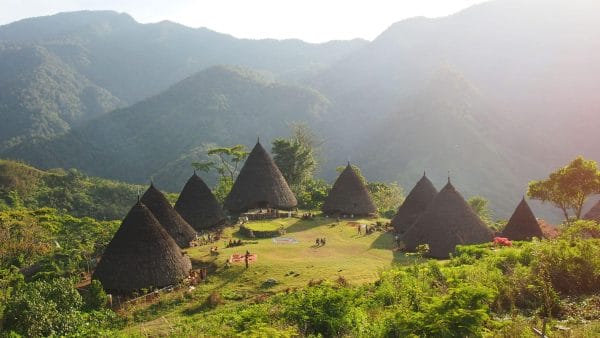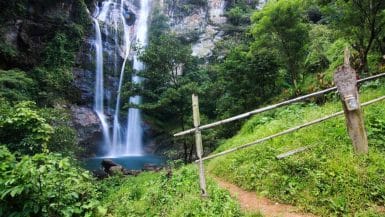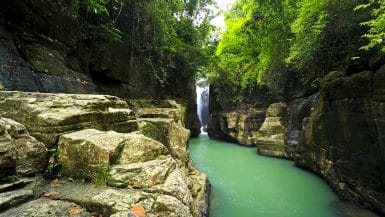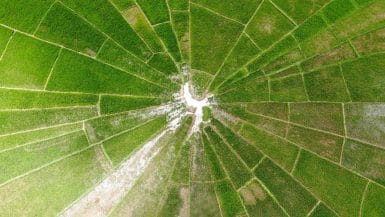Flores is undeniably a fascinating island to visit in the East Nusa Tenggara. The island offers an array of wonders, with Wae Rebo Village being one of the major ones. There is something so mystical about this traditional settlement that encourages many to marvel at its beauty, and you can get a glimpse of it in the following Wae Rebo Village travel guide.
Wae Rebo: A Mystical Village Above the Clouds
Wae Rebo is home to the Manggarai tribe situated in the West Maggarai Regency on the highland of Flores Island, Indonesia. According to the oral lore, the village was settled somewhere around 18 generations ago.
An elder of the community-led his tribe to the Flores highlands after a vision came to him. That was when the tribe established a settlement with the protection of a holy spirit. The local government began the initial moves toward developing Wae Rebo Village as a tourist attraction in 1997.
The authorities invested in two traditional circular cone-shaped houses called Mbaru Niang. As for the remaining early Mbaru Niang houses, they underwent a renovation conducted by a group of Jakarta-based professional architects.
Aside from its unique house shape, what distinguishes this small community is its location, approximately 3,608 feet above sea level and enclosed by deep woodland and panoramic undulating mountains.
The only way to get to this heritage destination is by trekking uphill for around 3-4 hours. Also, that’s only after making the four-hour drive from Labuan Bajo or Ruteng. Even so, many have completed the journey to this UNESCO awarded village.
How to Get to Wae Rebo Village
Having a trustworthy Wae Rebo Village travel guide is key to a smooth journey. The majority of visitors generally begin the trip from Labuan Bajo, for it’s used as a base to marvel at the surrounding attractions.
If you are traveling in a group, it would be best to take a package tour because it’s the easiest and probably most affordable option. In addition, everything will be taken care of for you, allowing you to sit back and relax without having to worry about everything and anything.
The trip to the hinterland of Flores is typically made in three days using the following route: Labuan Bajo – Lembor – Narang – Dintor – Denge – Wae Rebo. On the first day, you go for the car ride to Denge in which it’s the last village to Wae Rebo.
Despite the distance being just approximately 70 kilometers, the ride can take more than six hours due to the poor condition of the roads. While it’s a relatively steep, long journey, the majestic view of the Cancar spider web rice field along the way will keep you entertained.
Yet still, don’t underestimate the travel time, and make sure to get started in Labuan Bajo before midday. That’s because it’s highly impossible to drive on such difficult roads in the dark, and any surrounding natural beauties will almost certainly be invisible.
Upon arrival, you can spend the night in a lodge which you can only find in the village of Denge or Dintor. The next day is reserved for trekking to Wae Rebo Village, which takes around 3.5 hours should there be no concerning obstacles.
Breathtaking views of the bluish sea below and the triangular Mount Inerie, as well as diverse wilderness, will be your reward during the trekking. Not to mention the regular sightings of birds, monkeys, and butterflies that make the journey will ingrain forever in mind.
In the hazy cloud forest surrounding Wae Rebo Village, you may witness any kind of forest crops, such as cacao beans, coffee, taro, and cassava. A glimpse of the mountain valley accompanies you as you reach a point after what seems like ages of climbing.
Here, the roofs of the Wae Rebo houses can already be seen peeking out of the trees. This is where you will experience a truly magnificent moment. Also, after all the sweating, you will get the sensation that your effort is well worth it.
Where to Stay
Finding a place to stay for a night along the route from Labuan Bajo to Denge is never an easy task. Therefore, your departure schedule to the hinterland of Flores will significantly affect your choice of accommodation.
Some of the available homestays can be found in the villages of Denge and Dintor. Thus, if possible, try to get to Denge before the sun goes down. Denge is the last village prior to heading to Wae Rebo. Fortunately, the road to this village is still passable by car.
In any Wae Rebo Village travel guide, you will find that the Denge Home Stay is an excellent option to stay. Blasius Monta, a schoolteacher and an expert of Wae Rebo, runs this welcoming guesthouse which offers modest but well-taken care rooms in his lovely home for those who want to marvel at the beauty of Wae Rebo.
You can contact Blasius by telephone at (0813) 3935 0775. Also, it would be best if you call or text him before going there. Some tourists who have been there usually have difficulty contacting him due to the poor signal in Denge Village. If you are incapable of making a call, texting him will suffice.
This homestay is the ideal place to stay for it is only several feet away from the trail start to the land above the clouds, Wae Rebo. In addition, it will be much easier to get an early start after enjoying a simple yet delectable breakfast.
If you rent a room here, you can keep your belongings you might not need on the uphill. That way, you can reduce the burden of trekking from Denge to Wae Rebo and makes everything much more manageable.
As a teacher, the lodge owner enjoys reading and would highly appreciate it if visitors could leave one or two books behind. The cost each night in Denge Home Stay is 250,000 rupiah, already including dinner, breakfast, and lunch.
Not only will the visitors be able to take a good rest before a long journey, but they will also get a ton of brand new experience. This includes getting to taste the nutty red rice cultivated locally by the villagers and strong sambal made of green chili peppers.
Visitors may also ask the owner to open the Wae Rebo center, which is located next door. In this visitor center, you will find a collection of photos of the new Manggarai house built in 2009. Going to the Denge’s market on Monday would be great if you want to get closer to the local culture.
When to Visit Wae Rebo
The ideal time to visit Wae Rebo Village is between February and November when the weather is mild and there is little to no rainfall. Coming to the destination during the wet season won’t make an excellent choice. Instead, it will make the journey from Labuan Bajo to the trekking time much more difficult.
As for the trekking, starting it early between 5-6 am is advised. This way, you can reach the top in the midday and still get a lot of chance to rest while also enjoying the views and mingling with the native of Wae Rebo.
The Main Attractions
Being one of Indonesia’s most prevalent tourist attractions makes Wae Rebo well taken care of. One of the many appealing aspects of the community—apart from its cone-shaped houses—is how secluded it is.
It’s a 28-kilometer journey through the dense jungle from the village of Denge. Visiting this destination is currently only visible if you spend a night at the provided accommodation. The seclusion of Wae Rebo restricts the number of visitors, which makes the journey more about the actual experience.
The first thing visitors must do is go to the ceremonial house to meet the elders, who will later perform a prayer. Every visitor must also take part in the Waelu Ceremony. It’s a ceremony where the tribe leader will deliver a welcoming speech and pray for visitors to be safe during the visit.
After the ceremony, you can go to the visitors’ house where you will be served lunch. You may spend the day exploring the nearby valley, interacting with the locals, taking photographs, or simply immersing yourself in the peace and quiet of the Wae Rebo ambiance.
Some are coming here just to take pictures, and there’s nothing wrong with it. However, it’s advisable to take the available opportunity to get in-depth knowledge about the lives of the native in Wae Rebo Village. Mingle with them to know their thoughts or perhaps their philosophy of life as a part of a tribe.
Come to those you think are capable of explaining everything in a fun and straightforward way about this traditional village. The information you get will undoubtedly be a valuable lesson you may only obtain in some remote communities that require a lot of effort to visit.
If you come during the dry season, you will be fortunate as you get to enjoy the night sky packed with stars, making it a perfect moment for night photography. There is no need to worry about the place to stay during the night because you will get the opportunity to sleep in one of the huts. The price is around 250,000 per night for each person, including a clean toilet.
Final Thoughts
Is Wae Rebo Village worth visiting? If you’re simply interested in the unique shaped houses, you can see them in other villages which don’t require trekking. However, if you are a fan of a great challenge, Wae Rebo is your answer; and this Wae Rebo Village travel guide can help you to start off.





